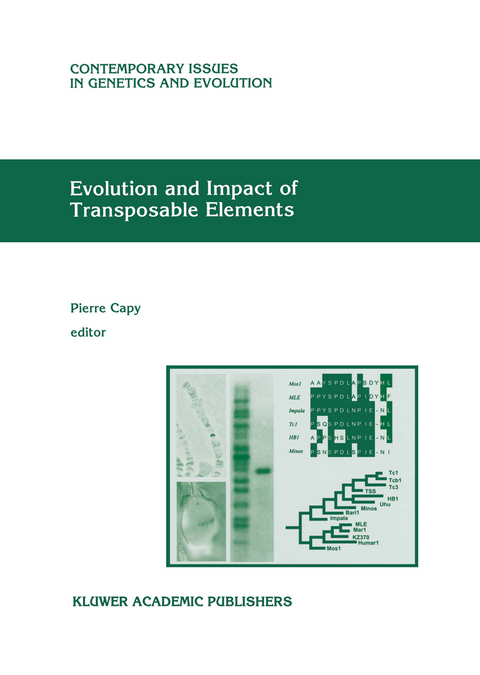
Evolution and Impact of Transposable Elements
Springer (Verlag)
978-94-010-6054-7 (ISBN)
During the last 50 years, the perception oftransposable elements (TEs) has changed considerably from selfish DNA to sequences that may contribute significantly to genome function and evolution. The recent increased interest in TEs is based on the realization that they are a major genetic component (at least 10--20%) of all organisms and a major contributor to the mutation process. It is currently estimated that 70--80% of spontaneous mutations are the result of TE-mediated insertions, deletions, or chromosomal rearrangements. Thus, it seems at least plausible that TEs may playa significant role in the adaptation and evolution of natural populations and species. The ubiquity of TEs suggests that they are an old component of genomes which have been vertically transmitted through generations over evolutionary time. However, detailed analyses carried out over the last 20 years have revealed several unusual features of TE evolution: (i) TEs can be horizontally transferred between species; (ii) TE evolutionary rates can be dramatically increased by specific inactivation processes, such as the RIP (Repeat Induced Point mutation) mechanism in fungi; (iii) TEs can influence the regulation of other TEs by insertion or deletion; (iv) different classes of TEs in even distantly related species can be remarkably similar in both structure and function.
I. Structure of transposable element.- LTR retrotransposons and the evolution of eukaryotic enhancers.- What makes Grande1 retrotransposon different?.- About the origin of retroviruses and the co-evolution of the gypsy retrovirus with the Drosophila flamenco host gene.- Structural analysis of Drosophila subobscura gypsy elements (gypsyDs).- Evolution of R1 and R2 in the rDNA units of the genus Drosophila.- Do the integrases of LTR-retrotransposons and class II element transposases have a common ancestor?.- II. Transposable elements and heterochromatin.- Evolutionary links between telomeres and transposable elements.- Constitutive heterochromatin and transposable elements in Drosophila melanogaster.- P element regulation and X-chromosome subtelomeric heterochromatin in Drosophila melanogaster.- III. Transposable elements and host phylogenies.- Quasispecies in retrotransposons: a role for sequence variability in Tntl evolution.- Genetic and molecular investigations on the endogenous mobile elements of non-drosophilid fruitflies.- Genomic distribution of the retrovirus-like element ZAM in Drosophila.- CM-gag, a transposable-like element reiterated in the genome of Culex pipiens mosquitoes contains only a gag gene.- IV. Dynamics and regulation of transposable elements.- Evidence for a host role in regulating the activity of transposable elements in Drosophila melanogaster: the case of the persistent instability of Baril elements in Charolles stock.- Plant S1 SINEs as model to study retroposition.- Maintenance of transposable element copy number in natural populations of Drosophila melanogaster and D. simulans.- Accumulation of transposable elements in laboratory ines of Drosophila melanogaster.- Regulation of the transposable element mariner.- The evolution of Ty1-copia group retrotransposons in eukaryote genomes.- The chromosomal distributions of Ty1-copia group retrotransposable elements in higher plants and their implications for genome evolution.- The Ty1-copia group of retrotransposons in plants: genomic organisation, evolution, and use as molecular markers.- BARE-1 insertion site preferences and evolutionary conservation of RNA and cDNA processing sites.- BARE-1D, a representative of a family of BARE-like elements of the barley genome.- The expression of the tobacco Tnt1 retrotransposon is linked to plant defense responses.- Fungal transposable elements and genome evolution.- Molecular domestication of mobile elements.- Genomic signatures: tracing the origin of retroelements at the nucleotide level C - Models of transposable elements dynamics.- Population genetics models of transposable elements.- A simulation of the P element horizontal transfer in Drosophila.
| Reihe/Serie | Contemporary Issues in Genetics and Evolution ; 6 |
|---|---|
| Zusatzinfo | VII, 309 p. |
| Verlagsort | Dordrecht |
| Sprache | englisch |
| Maße | 210 x 297 mm |
| Themenwelt | Medizin / Pharmazie ► Medizinische Fachgebiete |
| Studium ► 2. Studienabschnitt (Klinik) ► Humangenetik | |
| Naturwissenschaften ► Biologie ► Biochemie | |
| Naturwissenschaften ► Biologie ► Evolution | |
| Naturwissenschaften ► Biologie ► Zoologie | |
| ISBN-10 | 94-010-6054-1 / 9401060541 |
| ISBN-13 | 978-94-010-6054-7 / 9789401060547 |
| Zustand | Neuware |
| Haben Sie eine Frage zum Produkt? |
aus dem Bereich


